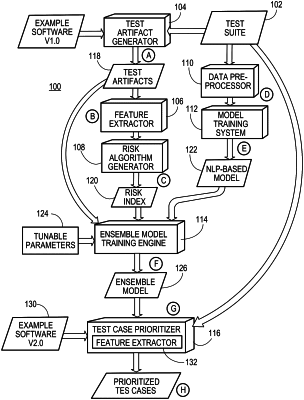| CPC G06F 11/3684 (2013.01) [G06F 11/3688 (2013.01); G06F 11/3692 (2013.01); G06F 18/214 (2023.01); G06F 40/42 (2020.01); G06N 20/20 (2019.01)] | 20 Claims |

|
1. A computer-implemented method comprising:
obtaining test artifacts that were generated as a result of testing one or more legacy versions of a software application using multiple test cases that were each executed multiple times;
extracting features from the test artifacts for each of the test cases, the features including a number of times each test case was executed and passed when testing the legacy versions, and a number of times that each test case was executed and failed when testing the legacy versions;
generating, for each of the test cases, a risk index value for the test case that reflects a risk that the test case was unnecessary or redundant when testing the legacy versions of software application, the risk index value being based at least on the extracted features;
training an ensemble model to generate, for a given input test case, a risk index value that reflects whether the given test case is likely unnecessary or redundant in connection with testing an updated version of the software application, the ensemble model being trained based on training data that includes, for each test case, (i) description data for the test case, (ii) the risk index value for the test case that reflects the risk that the test case was unnecessary or redundant for testing the legacy versions of the software application, (iii) the number of times that the test case was executed and passed when testing the legacy versions, and (iv) the and a number of times that the test case was executed and failed when testing the legacy versions;
for each test case of a candidate set of test cases, generating, using the trained ensemble model, a risk index value that reflects whether the test set of the candidate set is likely unnecessary or redundant in connection with testing the updated version of the software application; and
executing one or more test cases of the candidate set in connection with testing the updated version of the software application in a priority order that is determined based on the risk index values that are generated for the candidate set.
|